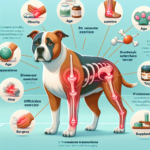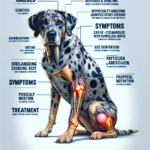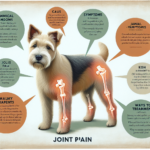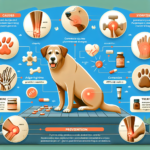Mastiff Joint Pain: Causes, Symptoms, Prevention, and Treatment
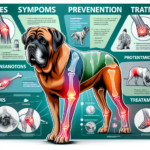
Introduction
Overview of Mastiffs: Mastiffs are a group of large, powerful dog breeds known for their imposing size, strength, and gentle temperament. Originating from ancient civilizations, Mastiffs have a rich history as guardians, war dogs, and companions. Notable breeds within this group include the English Mastiff, Bullmastiff, and Tibetan Mastiff. These dogs are characterized by their massive build, broad head, and short coat, making them both formidable protectors and affectionate family pets.
General Health Concerns: Due to their size and genetic background, Mastiffs are prone to several health issues, including heart problems, bloat, and joint-related conditions. Joint pain is a significant concern for Mastiffs, given their large frames and the stress it places on their joints.
Importance of Joint Health in Mastiffs: Joint health is crucial for Mastiffs because their large size makes them more susceptible to joint issues. Maintaining healthy joints is essential for their mobility, quality of life, and overall well-being. Early detection and management of joint pain can prevent severe complications and ensure a happier, more active life for these gentle giants.
Breed-Specific Joint Pain Risks
Genetic Predisposition
Mastiffs are genetically predisposed to several joint-related issues, including hip dysplasia, elbow dysplasia, and arthritis. Hip dysplasia, a condition where the hip joint doesn’t fit properly into the hip socket, is particularly common in large breeds like Mastiffs. Elbow dysplasia, involving abnormal development of the elbow joint, can also lead to significant pain and mobility issues. Arthritis, the inflammation of joints, often develops as a secondary condition due to these structural abnormalities.
Age-Related Risks
As Mastiffs age, the risk of joint pain increases. Typically, signs of joint issues may start to appear as early as 4-5 years old, but they become more pronounced in senior dogs (7 years and older). The wear and tear on their joints over time, combined with their genetic predisposition, make older Mastiffs particularly vulnerable to joint pain and related conditions.
Activity Level and Joint Stress
Mastiffs, despite their size, are not overly active dogs. However, their sheer weight can place significant stress on their joints, especially if they engage in high-impact activities. Working Mastiffs or those involved in activities like guarding or protection work may experience increased joint stress. Even regular activities like walking or playing can contribute to joint wear and tear over time.
Common Symptoms of Joint Pain in Mastiffs
General Symptoms
- Limping: One of the most noticeable signs of joint pain is limping or favoring one leg over another.
- Stiffness: Stiffness, especially after rest or in the morning, can indicate joint discomfort.
- Reluctance to Move: A dog that is hesitant to climb stairs, jump, or even go for walks may be experiencing joint pain.
- Swelling: Visible swelling around the joints can be a sign of inflammation.
- Behavioral Changes: Increased irritability or changes in behavior can also be indicative of pain.
Breed-Specific Symptoms
In Mastiffs, symptoms like difficulty rising from a lying position, a noticeable decrease in activity levels, and a reluctance to engage in play are particularly common. Due to their size, even minor joint issues can significantly impact their mobility and overall demeanor.
When to Consult a Vet
If you notice any of the above symptoms, it’s essential to consult a veterinarian promptly. Early intervention can prevent further deterioration and improve your Mastiff’s quality of life. Regular veterinary check-ups are also crucial for early detection and management of joint issues.
Preventive Measures for Joint Health
Exercise Recommendations
For Mastiffs, low-impact exercises are ideal for maintaining joint health. Activities like swimming, gentle walks, and controlled play sessions can help keep their joints flexible without causing undue stress. Avoid high-impact activities like jumping or running on hard surfaces, as these can exacerbate joint issues.
Dietary Suggestions
A balanced diet rich in essential nutrients is vital for joint health. Consider incorporating foods or supplements that contain glucosamine, chondroitin, and omega-3 fatty acids, which support joint function and reduce inflammation. High-quality commercial dog foods formulated for large breeds often include these nutrients.
Weight Management
Maintaining a healthy weight is crucial for reducing joint stress in Mastiffs. Obesity can exacerbate joint pain and lead to other health issues. Regularly monitor your dog’s weight and adjust their diet and exercise routine as needed to keep them at an optimal weight.
Early Screening and Monitoring
Regular veterinary check-ups and early screening for joint issues can help catch problems before they become severe. For Mastiffs, screening tests like X-rays or joint fluid analysis can be beneficial. Monitoring your dog’s movement and behavior for any signs of discomfort can also aid in early detection.
Treatment Options for Joint Pain
Non-Surgical Treatments
Non-surgical treatments for joint pain in Mastiffs include medications, physical therapy, and lifestyle adjustments. Anti-inflammatory drugs and pain relievers can help manage symptoms. Physical therapy, including exercises and massage, can improve joint function and reduce pain. Lifestyle adjustments, such as providing a comfortable bed and avoiding high-impact activities, can also be beneficial.
Surgical Options
In severe cases, surgical interventions may be necessary. Common surgeries for joint pain in Mastiffs include hip replacement, elbow surgery, and arthroscopy. These procedures can significantly improve mobility and reduce pain, but they come with risks and require a thorough discussion with your veterinarian.
Alternative Therapies
Alternative treatments like acupuncture, hydrotherapy, and massage can also benefit Mastiffs with joint pain. Acupuncture can help reduce pain and inflammation, while hydrotherapy provides low-impact exercise that strengthens muscles without stressing the joints. Regular massage can improve circulation and reduce muscle tension around the affected joints.
Lifestyle and Management Tips
Daily Care Routine
A daily care routine for a Mastiff with joint pain might include gentle morning walks, a balanced diet with joint supplements, and regular physical therapy sessions. Providing a comfortable resting area and monitoring their activity levels can also help manage their condition.
Modifying the Home Environment
Making your home more comfortable for a Mastiff with joint pain involves simple modifications like using ramps instead of stairs, providing orthopedic beds, and ensuring that food and water bowls are at an accessible height. These changes can reduce strain on their joints and improve their overall comfort.
Long-Term Management
Long-term management of joint pain in Mastiffs involves regular veterinary check-ups, consistent weight management, and ongoing physical therapy. Keeping your dog active with low-impact exercises and monitoring their condition can help maintain their quality of life.
FAQs About Mastiffs and Joint Pain
What are the early signs of joint pain in Mastiffs?
Early signs include limping, stiffness, reluctance to move, and behavioral changes such as irritability or decreased activity levels.
Can joint pain in Mastiffs be prevented?
While genetic predispositions cannot be entirely prevented, maintaining a healthy weight, providing a balanced diet with joint supplements, and engaging in low-impact exercises can help reduce the risk and severity of joint pain.
Are there specific foods that can help with joint health in Mastiffs?
Yes, foods rich in glucosamine, chondroitin, and omega-3 fatty acids can support joint health. High-quality commercial dog foods formulated for large breeds often include these nutrients.
When should I consider surgery for my Mastiff’s joint pain?
Surgery should be considered when non-surgical treatments are no longer effective, and the dog’s quality of life is significantly impacted. Consult with your veterinarian to discuss the best options for your pet.
How often should I take my Mastiff to the vet for joint health check-ups?
Regular check-ups every six months to a year are recommended, especially as your Mastiff ages. Early detection and management of joint issues can prevent severe complications.
Conclusion
Joint pain is a significant concern for Mastiffs due to their size and genetic predispositions. By understanding the causes, symptoms, preventive measures, and treatment options, owners can take proactive steps to ensure their Mastiff’s joint health. Regular veterinary check-ups, a balanced diet, appropriate exercise, and weight management are crucial for maintaining mobility and quality of life. Early intervention and consistent care can help your Mastiff lead a happy, active life despite joint pain.

